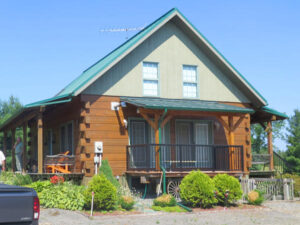Environmentally Responsible Without Costing a Fortune
 He was a fearsome hockey foe in his day, but Mike Ault has spent most of his time as a gentle partner to Mother Nature; an egg, dairy and cattle farmer in the Hanesville, Ontario area. “I believe in being as environmentally responsible as possible, with out spending a fortune,” says Mike, who installed geothermal in his house about 10 years ago and says it has always worked perfectly, with minimal annual service.
He was a fearsome hockey foe in his day, but Mike Ault has spent most of his time as a gentle partner to Mother Nature; an egg, dairy and cattle farmer in the Hanesville, Ontario area. “I believe in being as environmentally responsible as possible, with out spending a fortune,” says Mike, who installed geothermal in his house about 10 years ago and says it has always worked perfectly, with minimal annual service.
The house is 934 square feet, plus a loft and a basement. When the previous electric furnace became too old, Mike asked his Friend Jimmie Thom, from ATEL Air, to install a Bard GeoTec 3 ton two-stage heat pump that was connected to six-feet-deep horizontal geothermal trenches next to the building.
“They did a good job, nice and neat. They changed some of the ductwork, too.”
“I’m glad he liked our work,” says Jimmie with a wink. “I played against Mike in hockey. He was tough as nails on the ice. Wouldn’t want to get on his bad side.”
Jimmie explains that getting the ductwork right is important to avoid hot and cold spots in the house and unnecessary noise. His company has been installing geothermal in the Morrisburg area since 1984. They have 8 crews that work on all kinds of heating and air conditioning systems. He says they do about 10 geothermal systems each year for people who care about clean energy and want to save some money on heating and cooling. He describes a large recent geo job for Upper Canada Village, a nearby historical attraction. “They were spending about $500,000 a year on electricity, so at this point they’re raving about the money they’re saving.”
Mike estimates that summer cooling in his little house costs about $90 or $100 per month, and winter heat about $250 per month. “I have no regrets. It’s a lot less than the alternatives,” says Mike.
He also worked for a time for an excavation company and knew his way around trenching. He saved quite a bit of the up front costs of the system by taking care of digging his own geothermal field.
For those who are not as fortunate, the up front cost can seem daunting at first glance. But the equipment pays for itself in utility savings in about 10 years and lasts much longer. Geothermal heat pumps last about 20-30 years and geothermal fields last about 25-50 years.
“Financing is available so that you can make payments roughly equal to the amount you’re saving on utilities,” says Jimmie. “So it doesn’t really have to cost you anything to upgrade to a cleaner system.” He processes fast customer approvals on his iPad through a company called Snap Financial. The interest rate is about 8% or 9%. Some people can do better through their existing financial institution. More and more conventional banks are extending financing for clean energy upgrades.
“I wanted solar panels too but the local utility didn’t have enough local line capacity,” says Mike. “People in this area are going that way. Just a few miles east of here there’s a big wind power installation. I think we have to do what we can to protect Mother Earth.”












